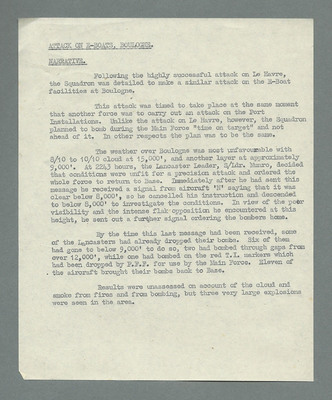Attack on e-boats, Boulonge - narrative
Title
Attack on e-boats, Boulonge - narrative
Description
Describes planned timing to attack at the same time as the main force. Reports that weather was unfavourable. After initially cancelling the operation leader checked out weather at low level but decided low visibility and target defences precluded attack. Some aircraft had already bombed but 11 aircraft brought bombs back to base.
Language
Format
One-page typewritten document
Publisher
Rights
This content is property of the Leonard Cheshire Archive which has kindly granted the International Bomber Command Centre Digital Archive a royalty-free permission to publish it. Please note that it was digitised by a third-party which used technical specifications that may differ from those used by International Bomber Command Centre Digital Archive. It has been published here ‘as is’ and may contain inaccuracies or culturally inappropriate references that do not necessarily reflect the official policy or position of the University of Lincoln or the International Bomber Command Centre.
Identifier
MCheshireGL72021-181210-030008
Transcription
[underlined] ATTACK ON E-BOATS, BOULOGNE. [/underlined]
[underlined] NARRATIVE. [/underlined]
Following the highly successful attack on Le Havre, the squadron was detailed to make a similar attack on the E-Boat facilities at Boulogne.
This attack was timed to take place at the same moment that another force was to carry out an attack on the Port Installations. Unlike the attack on Le Havre, however, the Squadron planned to bomb during the Main Force “time on target” and not ahead of it. In other respects the plan was to be the same.
The weather over Boulogne was most unfavourable with 8/10 to 10/10 cloud at 15,000’, and another layer at approximately 9,000’. At 2243 hours, the Lancaster Leader, S/Ldr. Munro, decided that conditions were unfit for a precision attack and ordered the whole force to return to Base. Immediately after he had sent this message he received a signal from aircraft ’N’ saying that it was clear below 8,000’, so he cancelled his instruction and descended to below 8,000’ to investigate the conditions. In view of the poor visibility and the intense flak opposition he encountered at this height, he sent out a further signal ordering the bombers home.
By the time this last message had been received, some of the Lancasters had already dropped their bombs. Six of them had gone to below 9,000’ to do so, two had bombed through gaps from over 12,000’, while one had bombed on the red T.I. markers which had been dropped by P.F.F. for use by the Main Force. Eleven of the aircraft brought their bombs back to Base.
Results were unassessed on account of the cloud and smoke from fires and from bombing, but three very large explosions were seen in the area.
[underlined] NARRATIVE. [/underlined]
Following the highly successful attack on Le Havre, the squadron was detailed to make a similar attack on the E-Boat facilities at Boulogne.
This attack was timed to take place at the same moment that another force was to carry out an attack on the Port Installations. Unlike the attack on Le Havre, however, the Squadron planned to bomb during the Main Force “time on target” and not ahead of it. In other respects the plan was to be the same.
The weather over Boulogne was most unfavourable with 8/10 to 10/10 cloud at 15,000’, and another layer at approximately 9,000’. At 2243 hours, the Lancaster Leader, S/Ldr. Munro, decided that conditions were unfit for a precision attack and ordered the whole force to return to Base. Immediately after he had sent this message he received a signal from aircraft ’N’ saying that it was clear below 8,000’, so he cancelled his instruction and descended to below 8,000’ to investigate the conditions. In view of the poor visibility and the intense flak opposition he encountered at this height, he sent out a further signal ordering the bombers home.
By the time this last message had been received, some of the Lancasters had already dropped their bombs. Six of them had gone to below 9,000’ to do so, two had bombed through gaps from over 12,000’, while one had bombed on the red T.I. markers which had been dropped by P.F.F. for use by the Main Force. Eleven of the aircraft brought their bombs back to Base.
Results were unassessed on account of the cloud and smoke from fires and from bombing, but three very large explosions were seen in the area.
Collection
Citation
“Attack on e-boats, Boulonge - narrative,” IBCC Digital Archive, accessed July 22, 2024, https://ibccdigitalarchive.lincoln.ac.uk/omeka/collections/document/16562.
Item Relations
| This Item | dcterms:relation | Item: Royal Air Force file cover - Boulogne, dusk 15/16 June 1944 |

